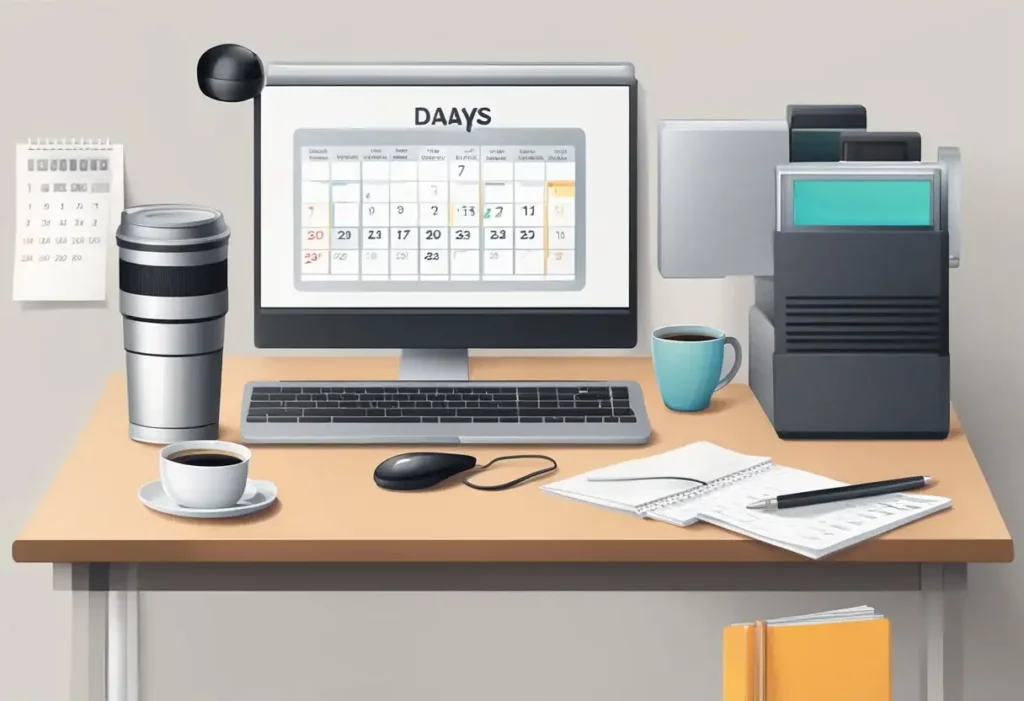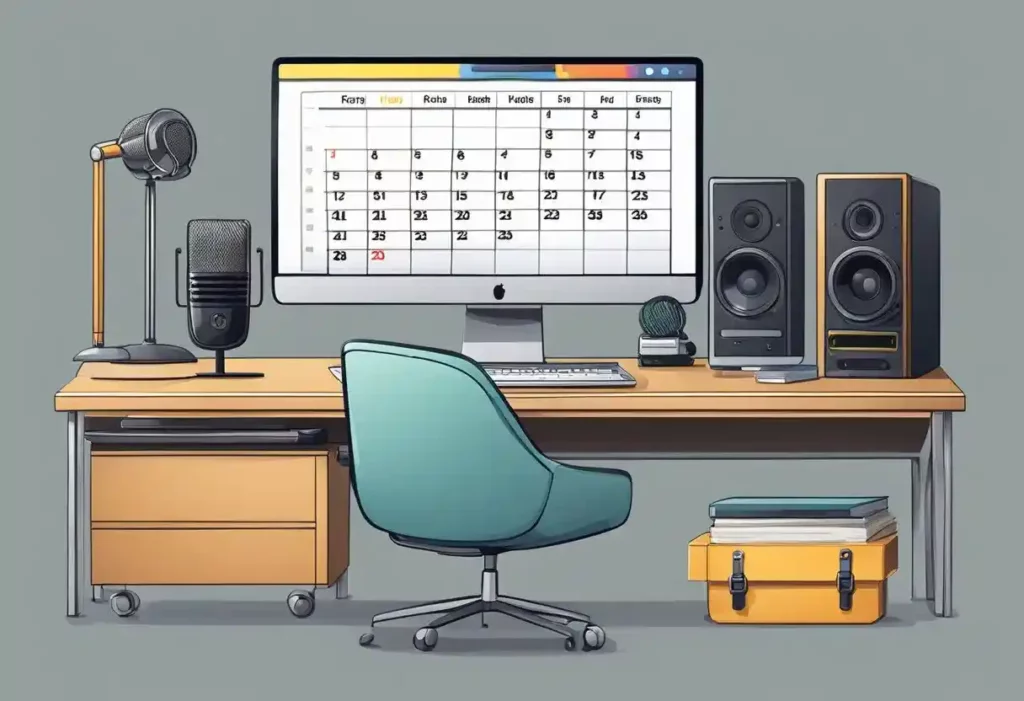How to Publish a Video Per Day for the Next 30 Days: A Daily Content Strategy

Publishing a video every day for the next 30 days is an ambitious goal that can drastically increase your online presence and engagement. This consistent stream of content provides your audience with regular updates and establishes a routine that can lead to increased viewer loyalty and brand recognition.
To achieve this, a well-crafted content strategy and a thorough understanding of your production capabilities are important.
By mapping out your topics, themes, and ideas before diving into content creation, you lay the groundwork for a month of valuable and consistent output.
Executing this plan requires a streamlined workflow from pre-production to publishing.
Key Takeaways
- Publishing daily videos requires a strategic content plan and efficient workflow.
- Technical preparation and a structured production process are integral for consistency.
- Audience engagement throughout the series strengthens community ties and offers feedback.
Formulating a Content Strategy

Formulating a content strategy involves a thorough understanding of the target audience, setting achievable goals, and identifying key themes and topics that resonate with viewers.
Understanding Your Audience
One must conduct meticulous audience research to ascertain their preferences, behavioral patterns, and consumption habits. This can involve analyzing metrics from previous content, surveying viewers, and monitoring discussions within the target demographic’s online communities.
Setting Clear Goals
Clear goals for the video series should be established. These could range from increasing brand awareness to driving a specific call to action. Goals need to be Specific, Measurable, Achievable, Relevant, and Time-bound (SMART).
Identifying Themes and Topics
Identifying themes and topics requires a creator to list subjects that are engaging and relevant to the audience. For instance, if the target audience is interested in fitness, potential topics might include workout routines, nutritional advice, and equipment reviews. It’s crucial to diversify content within these themes to maintain interest over the 30-day period.
Video Production Planning

Successful video production for a daily release schedule requires meticulous planning of content, time management, and alignment with marketing goals.
Creating a Content Calendar
A content calendar is essential for organizing and scheduling video topics to ensure a steady stream of material. A table format helps visualize the daily themes:
| Day | Date | Video Topic |
|---|---|---|
| 1 | 01/20/2024 | Introduction to Series |
| 2 | 01/21/2024 | Tutorial Part 1 |
| … | … | … |
| 30 | 02/18/2024 | Series Wrap-Up |
Each video should align with the overarching content strategy, providing viewers with a coherent and progressive experience.
Budgeting Time and Resources
Allocating time and resources efficiently is crucial. Creators should estimate and record the hours and equipment needed for each video:
- Pre-production (scripting, storyboarding): ~2 hours
- Production (filming): ~4 hours
- Post-production (editing, rendering): ~6 hours
Resources, such as camera equipment, lighting, and editing software, must be accounted for in the budget to prevent any production delays.
Aligning with Marketing Objectives
Videos should contribute to achieving marketing objectives. They must not only entertain but also drive viewer actions that support business goals. Key performance indicators (KPIs) must be outlined clearly:
- Audience reach: number of views and subscribers targeted per video
- Engagement: measurable via comments, likes, and shares
- Conversion rates: track how many viewers took the desired action after watching
Each video’s content and call-to-action should be strategically designed to meet these KPIs.
Content Creation Workflow 30 Day Plan

A systematic content creation workflow is essential to publish a video per day. It ensures consistency and efficiency, especially when working with tight schedules.
Storyboarding Each Video
Storyboarding is the first step in visualizing the content. The creator should outline key scenes and transitions to convey the narrative effectively. This can be as simple as a series of sketches or a detailed scene-by-scene breakdown. A sample storyboard might look like this:
- Scene 1: Introduction (Sketch of the opening shot with notes on dialogue or on-screen text)
- Transition: Fade to next scene
- Scene 2: Main content (Sketch of the central part of the video with key points listed)
- Scene 3: Conclusion (Closing shot with notes on call-to-action)
Scriptwriting Techniques
Good scriptwriting ensures that each video communicates its message clearly and engagingly. To maintain a consistent voice, the creator should:
- Utilize active voice and straightforward language.
- Weave in relevant story elements for engagement.
- Keep scripts concise to fit the intended video length.
Scripts should be formatted with clear headers, dialogue, and descriptions for visual or sound elements:
[Introduction] “Welcome to our daily video series! Today we’re talking about…”
[Main Content] “First, let’s look at…”
[Conclusion] “Remember to subscribe for more tips!”
Batch Filming
Batch filming maximizes the use of time and resources. Here’s a basic process:
- Preparation:
- Check equipment (camera, lighting, microphone)
- Set up filming space for multiple videos
- Filming:
- Record videos sequentially, minimizing setup changes
- Keep detailed notes on shots for easier editing
- Post-Production:
- Organize footage by video
- Begin the editing process while fresh in mind
Filming in batches means the creator can focus on producing several videos at once, which is more efficient than shooting daily.
Technical Setup in Video Production

In order to publish a video every day for 30 days, one’s technical setup must be efficient and reliable. Ensuring that the equipment is suitable for daily content production is critical.
Good lighting and sound dramatically enhance video quality, and a well-arranged shooting environment can streamline the production process.
Selecting the Right Equipment
One must choose equipment that balances quality with usability. For a basic setup, a DSLR or mirrorless camera capable of shooting in high-definition, or even a high-quality smartphone, can suffice for video recording.
Tripods and gimbals ensure stable footage, and a reliable computer with video editing software like Adobe Premiere Pro or Final Cut Pro is essential for post-production. Moreover, ample storage—such as external hard drives or cloud storage—is required to save daily video footage.
Understanding Lighting and Sound
Quality lighting and sound are non-negotiable for professional-looking videos. Implement a three-point lighting setup with a key light, fill light, and backlight to create a visually appealing scene.
For sound, a lavalier microphone or a shotgun microphone is preferred for clear audio, coupled with soundproofing methods like acoustic panels to reduce echo.
Optimizing Your Shooting Environment
A consistent shooting environment is key for quick setup and turnaround. This entails a quiet area with controlled lighting and a neutral backdrop.
Organizing tools and equipment in a dedicated space ensures everything is at arm’s reach. Additionally, maintaining a clean and clutter-free area helps to minimize distractions and post-production work.
Shooting the Video for 30 Days in Advance

Effective video shooting is essential for creating engaging content on a daily basis. This section outlines the fundamentals of camera handling, audio capture, and conducting interviews and monologues.
Camera Handling
- Steadiness: Use a tripod or stabilizer to ensure your video is smooth and not shaky, which can distract viewers.
- Composition: Frame your shots with the rule of thirds in mind, placing subjects off-center to create a more interesting visual.
Capturing High-Quality Audio
- Microphone Choice: Utilize a shotgun or lavalier microphone for clearer sound, and always test audio levels before recording.
- Environment: Choose quiet locations to avoid background noise, and if indoors, use soft furnishings to reduce echo.
Interviews and Monologues
- Eye Level: Position the camera at the subject’s eye level to create a more natural and engaging perspective.
- Lighting: Ensure the subject’s face is well-lit by using natural light or soft artificial lighting to avoid harsh shadows.
Post-Production Dates and Schedules

In the post-production stage, the creator refines their video to ensure clarity, engagement, and professional quality. This process is critical in maintaining consistency and audience interest throughout the 30-day challenge.
Editing for Clarity
After filming, the editor’s primary task is to structure the footage to convey the intended message clearly. They should:
- Trim unnecessary or redundant segments
- Arrange clips logically to maintain a coherent flow
- Use transitions judiciously to connect ideas smoothly
Adding Graphics and Effects
Visual elements greatly enhance the viewer’s experience. Creators should:
- Incorporate lower thirds for speaker names and titles
- Use callouts to highlight key points
- Add visual effects sparingly to emphasize certain parts without distracting from the message
Choosing Background Music
The right music can set the tone and engage the audience. When selecting background music, consider:
- The mood of the video should match the music’s tempo and style.
- Royalty-free music is a safe choice to avoid copyright issues.
- Volume levels should complement, not overpower, the spoken content.
Publishing the Video With Schedule

When aiming to publish a video each day, one should focus on platform requirements, SEO optimization, and crafting compelling thumbnails.
Understanding Platform Requirements
Each video-sharing platform has specific requirements that one must adhere to for successful video publication. For instance, YouTube demands a maximum video file size of 128GB or 12 hours in length, whichever is less.
One should also be aware of the accepted video formats such as .MP4, .MOV, and others. Uploading should follow the recommended settings for video and audio codecs, ensuring compatibility and quality.
Key Video Specifications for Major Platforms
| Platform | Max File Size | Max Length | Recommended Video Format |
|---|---|---|---|
| YouTube | 128GB | 12 hours | .MP4, .MOV, .AVI |
| Vimeo | 500MB/week | No limit | .MP4, .MOV, .WMV |
| 10GB | 240 min | .MP4, .MOV |
Optimization for Search Engines
To improve visibility, videos should be optimized for search engines, which involves the strategic use of titles, descriptions, and tags. Titles should be clear, descriptive, and include relevant keywords without clickbait. Descriptions offer an opportunity to expand on the title and inject additional keywords and phrases. Tags should also be thoughtfully selected to improve the video’s discoverability.
SEO Checklist for Video Publishing
- Title: Short and includes main keyword.
- Description: Detailed, includes secondary keywords, and a call to action.
- Tags: Relevant and includes a mix of broad and specific tags.
Creating Effective Thumbnails
An effective thumbnail can significantly affect a video’s click-through rate. Thumbnails should be high-resolution images that represent the content clearly, with added text overlays to provide context. Use bold and easy-to-read fonts to catch viewers’ attention. Additionally, maintaining a consistent style can help with brand recognition.
Thumbnail Design Tips
- Resolution: 1280×720 pixels, maintaining a 16:9 aspect ratio.
- Font: Bold and large enough to read.
- Imagery: High contrast and relevant to the video content.
Promotion and Distribution
To effectively amplify the reach of daily published videos, creators must adopt a systematic approach to promotion and distribution which encompasses various channels and strategies.
Leveraging Social Media
By utilizing platforms such as Facebook, Twitter, and Instagram, creators can tease upcoming content and share snippets of their videos to pique interest. They should:
- Schedule posts to coincide with video releases using tools like Hootsuite or Buffer.
- Utilize hashtags related to their content for better visibility.
Email Marketing Integration
Email campaigns can be a powerful method to keep subscribers informed. Creators should:
- Embed video links in their emails to drive direct views.
- Segment their email list based on viewer interests for targeted promotions.
Collaborations and Cross-Promotions
Engaging in partnerships with other content creators or brands can:
- Expose videos to a broader audience.
- Leverage the followers of collaborators through shared content and shoutouts.
Engagement and Community Building
Publishing a video each day cultivates an active community, which requires a creator’s commitment to engagement strategies and community management tactics.
Encouraging Viewer Interaction
A critical strategy is directly asking viewers to like, share, and subscribe. By posing questions pertinent to the video content, creators encourage viewers to comment, sparking discussions and further engagement. Use calls-to-action (CTAs) at the end of each video and utilize:
- Interactive polls: They can gauge viewer interest and encourage participation.
- Quizzes: Integrate trivia or challenge questions related to the video content.
Managing Comments and Feedback
Monitor and respond promptly to comments to maintain a positive community culture. A structured approach includes:
- Timely responses: Set aside specific times daily to address comments.
- Community moderators: Enlist reliable moderators to help manage interactions.
Creators should develop policies for handling negative feedback constructively and ensure these are clearly communicated to both viewers and moderators.
Building a Follower Base
Consistent video uploads at predetermined times can aid in building a devoted following. Creators should:
- Highlight followers: Feature subscriber content or shoutouts in videos.
- Exclusive content: Offer special content for followers, such as behind-the-scenes footage or previews.
Networking with other creators and cross-promotion can also expand reach and follower numbers by introducing new audiences to the channel.
Analytics and Performance Tracking
Effective analytics and performance tracking are crucial for understanding how each video performs and informs strategies for future content.
Measuring Video Success
To accurately assess video success, creators should track Key Performance Indicators (KPIs) such as views, likes, and shares. These metrics offer a tangible measure of engagement and reach. For example:
- Views: Total count of video plays
- Likes: Indicator of viewer appreciation
- Shares: Measure of content virality
Analyzing Viewer Behavior
Viewer behavior analytics involve examining watch time, audience retention, and click-through rates (CTR). These metrics provide insights into the content’s ability to captivate the audience. A table format can be useful here:
| Metric | Description |
|---|---|
| Watch Time | The total amount of time viewers have spent watching a video |
| Audience Retention | The percentage of the video watched by viewers on average |
| CTR | The percentage of viewers who click on a thumbnail to watch |
Adjusting Strategy Based on Data
Data analysis should directly influence future video strategies. For instance:
- Low Audience Retention: May indicate the need for shorter or more engaging content
- High CTR but Low Watch Time: Suggests that while thumbnails are effective, the content may not meet expectations
Regular adjustments based on data help tailor content to audience preferences, enhancing the chance for success in the campaign of publishing a video per day.
Frequently Asked Questions
What are the best strategies for uploading daily videos on YouTube?
Establishing a content calendar, batch filming, and maintaining a consistent theme are key strategies. Creators should also focus on efficient editing workflows and prioritize time management to ensure regular uploads.
Can scheduling my YouTube videos in advance impact my channel’s performance?
Scheduling videos can positively impact a channel’s performance by allowing creators to maintain a consistent posting schedule, which is crucial for audience retention and algorithm favorability.
What is the maximum number of YouTube Shorts I can upload in a single day?
There is no official limit to the number of YouTube Shorts one can upload in a day. However, creators should balance quantity with quality to retain their audience’s interest.
How do I effectively use YouTube’s scheduling feature for my daily uploads?
One should plan their content in advance and use YouTube’s scheduling feature to upload videos at times when their audience is most active. This ensures consistency and relieves the pressure to manually publish every day.
What are the potential outcomes of uploading to YouTube every day over an extended period?
Regular uploading can lead to increased viewer retention, improved engagement, and better algorithm ranking, which might contribute to enhanced visibility and channel growth. However, it’s important for creators to monitor burnout and maintain content quality.

